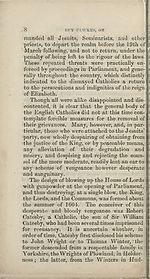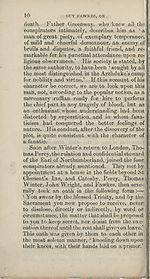Download files
Complete book:
Individual page:
Thumbnail gallery: Grid view | List view

THE GUNPOWDE3 PLOT. f)
; dington, in Worcestershire, where they had
been in possession of estates since the time of
I Henry VI. At a conversation held between
I these conspirators, it was agreed that Winter
should go over to the Netherlands to meet Ve-
ilasco, constable of Castile, who had arrived at
Flanders on his way to England to conclude a
i peace between James and the King of Spain,
and him to solicit his Majesty to recal the penal
i'laws against the Catholics, and to admit them
iiinto the rank of his other subjects. Winter
received no encouragement from Velasco that
ihe would stipulate in the treaty of peace for
the liberties of the English Catholics; and so
[| returned to England, taking Fawkes along
v with him, but without, at that time, communi-
II eating to him the nature of Catesby’s purpose.
Guido, or Guy Fawkes, whose name has
been more generally associated with this plot
than that of any of the other conspirators, in
I consequence of the prominent part he under¬
took in the execution of it, was a gentleman of
3 good family and respectable parentage in York-
| shire. His father, Edward Fawkes, was a
t notary at York, and held the office of Registrar
and Advocate of the Consistory Court of the
Cathedral. Of the education and early history
of Guy Fawkes nothing is known ; but having
spent the little property he derived from his
father, he enlisted as a soldier of fortune in the
Spanish army in Flanders, and was present at
the taking of Calais by the Archduke Albert
in 1598. He was well known to the English
j Catholics, and had been despatched by Sir
William Stanley and Owen from Flanders to
join Christopher Wright on his embassy to
Philip II., immediately after Queen Elizabeth’s
; dington, in Worcestershire, where they had
been in possession of estates since the time of
I Henry VI. At a conversation held between
I these conspirators, it was agreed that Winter
should go over to the Netherlands to meet Ve-
ilasco, constable of Castile, who had arrived at
Flanders on his way to England to conclude a
i peace between James and the King of Spain,
and him to solicit his Majesty to recal the penal
i'laws against the Catholics, and to admit them
iiinto the rank of his other subjects. Winter
received no encouragement from Velasco that
ihe would stipulate in the treaty of peace for
the liberties of the English Catholics; and so
[| returned to England, taking Fawkes along
v with him, but without, at that time, communi-
II eating to him the nature of Catesby’s purpose.
Guido, or Guy Fawkes, whose name has
been more generally associated with this plot
than that of any of the other conspirators, in
I consequence of the prominent part he under¬
took in the execution of it, was a gentleman of
3 good family and respectable parentage in York-
| shire. His father, Edward Fawkes, was a
t notary at York, and held the office of Registrar
and Advocate of the Consistory Court of the
Cathedral. Of the education and early history
of Guy Fawkes nothing is known ; but having
spent the little property he derived from his
father, he enlisted as a soldier of fortune in the
Spanish army in Flanders, and was present at
the taking of Calais by the Archduke Albert
in 1598. He was well known to the English
j Catholics, and had been despatched by Sir
William Stanley and Owen from Flanders to
join Christopher Wright on his embassy to
Philip II., immediately after Queen Elizabeth’s
Set display mode to:
![]() Universal Viewer |
Universal Viewer | ![]() Mirador |
Large image | Transcription
Mirador |
Large image | Transcription
Images and transcriptions on this page, including medium image downloads, may be used under the Creative Commons Attribution 4.0 International Licence unless otherwise stated. ![]()
| Chapbooks printed in Scotland > Treason > Guy Fawkes, or The history of the gunpowder plot > (9) |
|---|
| Permanent URL | https://digital.nls.uk/108834342 |
|---|
| Description | Over 3,000 chapbooks published in Scotland in the 18th and 19th centuries. Subjects include courtship, humour, occupations, fairs, apparitions, war, politics, crime, executions, Jacobites, transvestites, and freemasonry. Chapbooks are small booklets of 8, 12, 16 and 24 pages, often illustrated with crude woodcuts. Produced cheaply and sold by peddlars on the streets, they formed the staple reading material of the common people, along with broadsides. |
|---|---|
| Additional NLS resources: |
|

